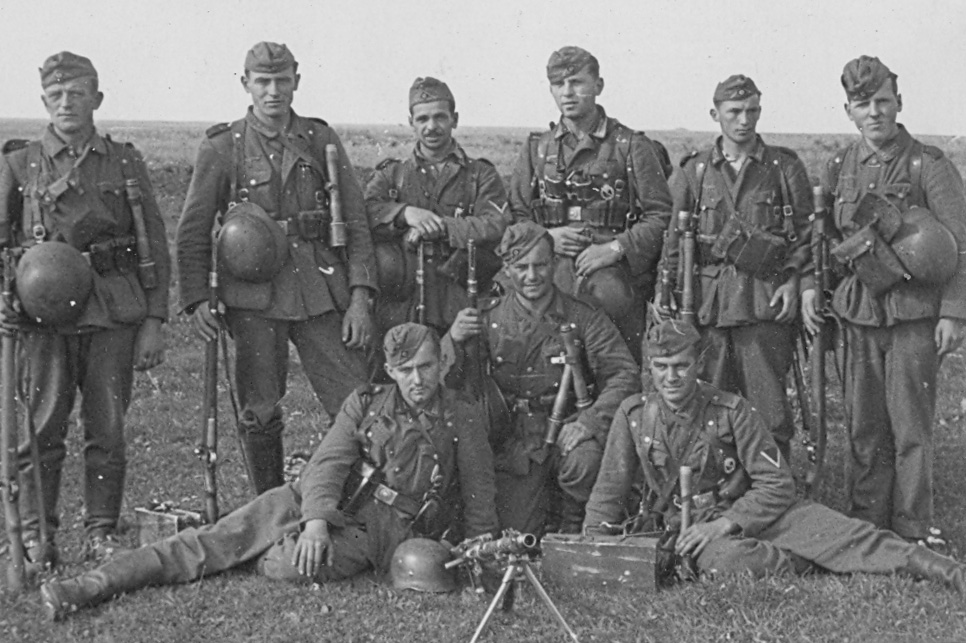
Feldbluse Sizing
The German tunic (Feldbluse) of the Second World War was a well-engineered garment, designed look sharp and be functional. However, it was overly complex, which certainly caused manufacturing difficulties both in WWII and for today's reproductions.
Despite claims by many manufacturers of reproduction uniforms, very few, if any, have actually managed to duplicate the pattern and sizing system. Aside from the complexity of the garment itself, there are three main reasons for these failings- lack of original examples, a lack of understanding of the sizing system, and the tendency to associate the tunic with a suit coat.
Original Heer uniforms are not particularly difficult to find- but they are relatively expensive, with examples in good condition costing about $1,500-$5,000 at the time of this writing. To accumulate a wide range of sizes and styles can cost tens of thousands of dollars. Further complicating this is the fact that many tunics were altered during the War, which often ruins any patterning value they may have had.
The "secrets" of German uniform sizing are stamped right in the tunics themselves. Unlike the US Army, which simply used the chest size and length, the ever-anal-retentive Germans include the chest and neck measures, and the sleeve, waist and hem lengths. Later tunics also give the height range of the soldier the tunic is intended to fit.
The biggest mistake made by most reproductions, is their application of suit coat patterning standards to the German tunic. These have been around for years and it's an understandable error. The grading rules (how the parts of the garment "grow" or "shrink" as the size changes) are readily available in books and online. Even the best of the best reproductions sometimes used these standards. All one needs is a tape measure to figure that out.
What's my documentation? My favorite social media reenacting celebrity who has a vast collection of reproductions says otherwise!
Well, we've been making German uniforms for nearly 30 years, we have several dozen originals on hand to check, plus WWII tailoring standards and tunic specifications, the hdv 337 German Army sizing guide, and we've dis-assembled numerous originals to verify our patterns. That's about all.
How did the Germans size their Tunics?
The Wehrmacht's sizing system very German; entirely systematic and logical, yet in practice it could be a supply sergeant's nightmare. The WWII German tunic sizing allowed a very exacting fit to be ordered for each soldier. Like most uniforms, tunics were sized by chest measurement and length, the latter being indicated by the torso length (Rückenlänge).
If all chest (32-50) and length combinations are considered, there are over 128 possible sizes (as compared with about 50 sizes for US Service Coats.) Each chest size also could be ordered with 3 different neck sizes and each torso length had 3 possible sleeves...once those are figured in, 128 becomes over 1100 possible unique size combinations. Typical German.
Number Blocks: The series of numbers stamped inside the tunics tells most of the story. Here we break them down to help you understand what they mean. Most tunics have a block of 5 measurements stamped inside the placket. A few have additional measurements- this will be addressed below.
Note: I have found many markings in original uniforms to be incorrect- some by 1 or 2 cm, while a few had chest sizes that were off by 8-10 cm. Conversely, if the uniform is unissued, and has a hand written inspector label, those have always been correct.
Chest sizes: Tunics are first sized by the soldier's chest. The number stamped in the tunic represents the size chest it will fit, not the actual measurement of the tunic. The garment typically measures 8-10cm larger than marked to allow for undergarments and freedom of movement. Thus, a "size 100" will measure about 110cm. Original uniforms were made in essentially .75" (2cm increments) starting at 86cm.
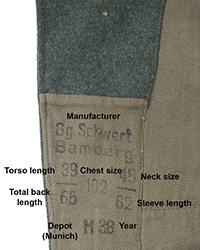
Here's how to read the tunic size stamps. All numbers are in centimeters.
|
Standard
Tunic Markings
|
|
45
(torso length)
|
|
44
(Neck)
|
|
|
100
(Chest)
|
|
|
75
(Total Back)
|
|
67
(Sleeve)
|
|
B43
Depot (Berlin) and year (location can vary)
|
|
Some Late War
('43-'44) M43 Tunics
|
|
172-176
(Height range of tunic)
|
|
|
96
(Chest)
|
|
|
43
(Torso Length)
|
|
62
(Sleeve)
|
|
M44
Depot (Munich) and year
|
Note: There are a few other variations of the number block. Some tunics also have the waist size stamped below or beside the chest. It is typically 10cm smaller- thus you'll see "90 80" in the center rather than simply "90".
Length: Next, the length must be determined. Instead of "shorts", "regulars", etc, the Germans indicated the length by the Rückenlänge translated as "torso length".
|
What is the torso length?
The distance from the base of the collar
to the level of the center belt hook holes.
|
|
|
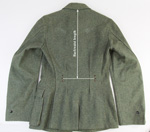
|
|
Torso Length: The length of a German tunic is determined by the upper left-hand number on the size stamp. This is the Rückenlänge or torso length, sometimes translated as "back waist" or "belt line". It's measured from the base of the collar to the level of the center belt hook hole. In theory, this places the belt at the wearer's natural waist, the narrowest part of the torso. It is not based on the height of the soldier's elbow!
German tunics came in no less than 8 back waist lengths, each of which is designed to fit a soldier of a certain height. Heer uniforms use back waist lengths of 37, 39, 41, 43, 45, 47, and 49. Those cover soldiers from 145cm (under 5ft.) to 200cm (6ft. 6in) in height. SS and LW tunics use even or odd numbers 38-49 so they have at least 12 possible lengths. The reason for this difference is unknown. Hdv 337 notes that (Heer) Feldblusen only come in odd number lengths as the belt hooks offer 1cm of adjustment longer or shorter. Thus, a tunic with a length of 45, can be adjusted to 44 or 46 by using the upper or lower belt hook holes.
This length system remains constant throughout all chest sizes.
For those who demand documentation...here it is. Heeres Druckvorschriften 337: "Regulations for the sizing of the most important uniform items".

|
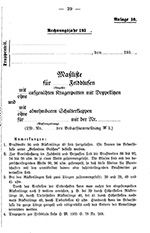
|
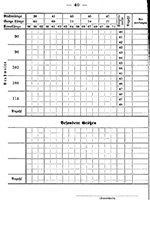
|
|
|
General explanation
of lengths
|
Sample order form
for Quartermasters
|
Total Back: (Ganze Länge) The distance from the base of the collar to the hem of the skirt. This was dispensed with on some late War number blocks. By taking the difference of the Back length and total back, one can arrive at the skirt length. This can matter when checking for SS tunics, which usually have shorter skirts than comparable length Heer tunics.
Sleeve Lengths: There is more variation here than with the torso lengths. Although it would seem reasonable to have a stock sleeve length for each Rückenlänge, we have found this not to be the case when we surveyed dozens of original uniforms. Each length of tunic (for example, "43") can have a range of sleeves lengths, typically varying by 3-4 cm. Say 62, 63 or 64 on 43 Rückenlängen. So, some tunics will have cuffs that end below the skirt, and other will be higher. Why or how this was determined is unknown.
Neck Size: The circumference of the collar is associated with the chest size. Each chest size will normally have one of two possible collar sizes. A 96 typically has a 42 or 43, a 104 has a 44 or 45 and so forth. Again, anomalies exist, but there is a distinct average.
Depot and year: The Munich Depot has always flustered newbies- they lose their minds when they see an M43 tunic stamped "M44". The letter is not "model" but rather an abbreviation for whatever regional depot the factory was associated with. The year is the year of manufacture, not the tunic type or model.
So, picking a uniform was simply a matter of checking the chest size of the soldier, then noting his height, follow the chart (or the the stamps in the tunic) and presto! However, in practice, I'm sure so many possible combinations (at least 128 possible sizes) must have caused nightmares for supply personnel and many, many German soldiers did not get the precise size and length garment as prescribed by the regulation. This is born out by looking at period photos.
Height Range: Some later War tunics (and trousers) are marked with the height range the garment is designed to fit. Normally, it's a 4 or 5cm bracket, such as 171-175, or 170-175. At times the back length and sleeve length are dropped from the number block, while others retain all five numbers, plus the height range. Each Rückenlänge corresponds to a height range. The ranges and Rückenlängen below were gleaned from original tunics and wartime tailoring publications, not from a blue ribbon panel of action doll collectors. The longer sizes were extrapolated as long tunics are very hard to find.
Again, many soldiers certainly were issued tunics that did not conform to this chart due to the realities of military supply and the wartime shortages.
|
Height range (cm)
|
Torso Length (cm)
|
|
156-160
|
37
|
|
161-165
|
39
|
|
166-170
|
41
|
|
171-175
|
43
|
|
176-180
|
45
|
|
182-189
|
47
|
|
190-197*
|
49
|
|
|
|
|
|
|
|
|
Common Feldbluse Myths
All German Tunics were the same length. Absolutely not. This myth was largely created by one the US manufacturers of reproductions some years ago. The Germans contradict this fantasy- according Hdv337, wartime tailoring guidelines, original tunics themselves, Feldblusen were made in at least seven different lengths.
|
The end of the
"all tunics were short" myth.
|
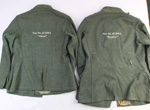
|
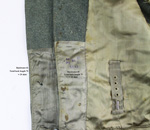
|
|
Factory uniforms with no modifications, same chest size (94), but not the
same length.
|
Same original M42 tunics,
size 94 chest: one
is 41/70 long and the other
is 45/75. Clearly different.
End of story.
|
The sleeves are always longer than the skirt: BS. It depends on the individual tunic. The shorter the tunic, the more likely this is to happen. SS tunics have shorter skirts than the corresponding length Heer tunic, so their sleeves tend to look longer. There is no predetermined relationship between the cuff and the hem. On average, they seem to run roughly even or slightly longer. Again, look at original tunics to verify this for yourself.
The second and bottom buttons are aligned with the breast and hip pockets: That's far too simple and logical. The lowest button is placed 3cm below the waistline (level of the middle belt hook hole), the topmost 2cm below the collar and the rest are evenly spaced in between. This means alignment with the pockets varies depending on the uniform size, pocket height and placement. Curiously, the SS does appear to align their buttons with the pocket tops. (We do this as well on our reproductions to keep the peace.)
The SS never wore "Army" pattern tunics: More fantasy. This is the exception rather than the rule, but it happened. And, just as you see Heer troops occasionally wearing SS camouflage, a few certainly ended up with SS pattern tunics for one reason or another.
The Germans had model numbers: No. The model numbers are collector inventions, used to differentiate the variations of Feldbluse. The OKW periodically issued changes for the "Feldbluse", such as gray collars, and eliminating pleats on pockets, etc.. A soldier's tunic was simply his "Feldbluse".
|